Related Research Articles

Francis William Aston FRS was a British chemist and physicist who won the 1922 Nobel Prize in Chemistry for his discovery, by means of his mass spectrograph, of isotopes in many non-radioactive elements and for his enunciation of the whole number rule. He was a fellow of the Royal Society and Fellow of Trinity College, Cambridge.
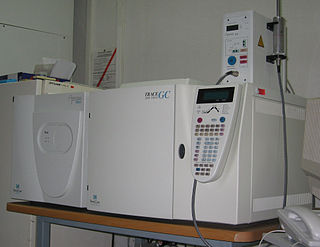
Gas chromatography–mass spectrometry (GC–MS) is an analytical method that combines the features of gas-chromatography and mass spectrometry to identify different substances within a test sample. Applications of GC–MS include drug detection, fire investigation, environmental analysis, explosives investigation, food and flavor analysis, and identification of unknown samples, including that of material samples obtained from planet Mars during probe missions as early as the 1970s. GC–MS can also be used in airport security to detect substances in luggage or on human beings. Additionally, it can identify trace elements in materials that were previously thought to have disintegrated beyond identification. Like liquid chromatography–mass spectrometry, it allows analysis and detection even of tiny amounts of a substance.
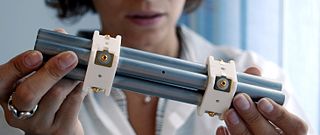
In mass spectrometry, the quadrupole mass analyzer is a type of mass analyzer originally conceived by Nobel laureate Wolfgang Paul and his student Helmut Steinwedel. As the name implies, it consists of four cylindrical rods, set parallel to each other. In a quadrupole mass spectrometer (QMS) the quadrupole is the mass analyzer – the component of the instrument responsible for selecting sample ions based on their mass-to-charge ratio (m/z). Ions are separated in a quadrupole based on the stability of their trajectories in the oscillating electric fields that are applied to the rods.

Arthur Jeffrey Dempster was a Canadian-American physicist best known for his work in mass spectrometry and his discovery in 1935 of the uranium isotope 235U.
Wilhelm Walcher was a German experimental physicist. During World War II, he worked on the German nuclear energy project, also known as the Uranium Club; he worked on mass spectrometers for isotope separation. After the war, he was director of the Institute of Physics at the University of Marburg. He was a president of the German Physical Society and a vice president of the German Research Foundation. He helped found the Society for Heavy Ion Research and the German Electron Synchrotron DESY. He was also one of the 18 signatories of the Göttingen Manifest.

The history of mass spectrometry has its roots in physical and chemical studies regarding the nature of matter. The study of gas discharges in the mid 19th century led to the discovery of anode and cathode rays, which turned out to be positive ions and electrons. Improved capabilities in the separation of these positive ions enabled the discovery of stable isotopes of the elements. The first such discovery was with the element neon, which was shown by mass spectrometry to have at least two stable isotopes: 20Ne and 22Ne. Mass spectrometers were used in the Manhattan Project for the separation of isotopes of uranium necessary to create the atomic bomb.
Consolidated Engineering Corporation was a chemical instrument manufacturer from 1937 to 1960 when it became a subsidiary of Bell and Howell Corp.
Atlas Werke was a German shipbuilding company, located in Bremen. It was founded in 1911.
Robert Graham Cooks is the Henry Bohn Hass Distinguished Professor of Chemistry in the Aston Laboratories for Mass Spectrometry at Purdue University. He is an ISI Highly Cited Chemist, with over 1,000 publications and an H-index of 144.

Christie G. Enke is a United States academic chemist who made pioneering contributions to the field of analytical chemistry.
Scott A. McLuckey is an American chemist, the John A. Leighty Distinguished Professor of Chemistry at Purdue University. His research concerns the formation of ionized versions of large biomolecules, mass spectrometry of these ions, and ion-ion reactions.

Josef Mattauch was a nuclear physicist and chemist. He was known for the development of the Mattauch-Herzog double-focusing mass spectrometer, for his work on the investigation of isotopic abundances using mass spectrometry, and the determination of atomic weights. Much of his career was spent at the Kaiser Wilhelm Institute for Chemistry.
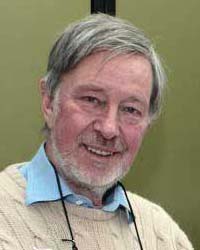
Franz Hillenkamp was a German scientist known for his development of the laser microprobe mass analyzer and, with Michael Karas, matrix-assisted laser desorption/ionization (MALDI).

Sibyl Martha Rock was an American inventor who was a pioneer in mass spectrometry and computing. Rock was a key person in Consolidated Engineering Corporation's (CEC) mass spectrometry team at a time when mass spectrometers were first being commercialized for use by researchers and scientists. Rock was instrumental in developing mathematical techniques for analyzing the results from mass spectrometers, in developing an analog computer with Clifford Berry for analysis of equations, and in sustaining an ongoing dialog between engineers and customers involved in development of both the mass spectrometer and an early digital computer, CEC's Datatron.
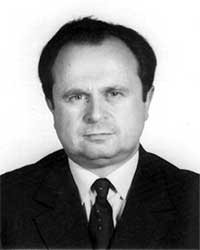
Victor Lvovich Talrose was a Russian scientist and mass spectrometrist. He was known as the “Father of Russian Mass Spectrometry” and was the author of 440 articles and 6 monographs.

Aerosol mass spectrometry is the application of mass spectrometry to the analysis of the composition of aerosol particles. Aerosol particles are defined as solid and liquid particles suspended in a gas (air), with size range of 3 nm to 100 μm in diameter and are produced from natural and anthropogenic sources, through a variety of different processes that include wind-blown suspension and combustion of fossil fuels and biomass. Analysis of these particles is important owing to their major impacts on global climate change, visibility, regional air pollution and human health. Aerosols are very complex in structure, can contain thousands of different chemical compounds within a single particle, and need to be analysed for both size and chemical composition, in real-time or off-line applications.
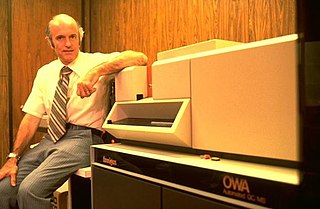
Robert Emmet Finnigan was an American pioneer in the development of gas chromatography–mass spectrometry equipment (GC/MS). Finnigan founded the Scientific Instruments Division of Electronic Associates, Inc., producing the first commercial quadrupole mass spectrometer in 1964. He then formed Finnigan Instruments Corporation to combine a computer system with a quadrupole mass spectrometer and gas chromatograph. Finnigan's GC/MS/computer systems are used to detect and identify trace organic compounds, making them important instruments for the monitoring and protection of the environment. They were adopted by the United States Environmental Protection Agency as a standard instrument for monitoring water quality and were fundamental to the work of the EPA.
Arthur John Ahearn was an American physicist and mass spectrometry researcher.
Angus Ewan Cameron was an American chemist known for his work on isotopic enrichment of uranium-235 for the purpose of building atomic bombs and his research on mass spectrometry.
Hisashi Matsuda was a Japanese physicist known for his work in ion optics and mass spectrometry, specifically known for his contributions to instrument design.
References
- 1 2 3 4 5 6 7 8 ten Noever de Brauw Michael C (1997). "A short story about the life of Curt Brunnée". Rapid Commun Mass Spectrom. 11 (6): 708–13. doi:10.1002/(SICI)1097-0231(199704)11:6<708::AID-RCM905>3.0.CO;2-S. PMID 9149437.
- 1 2 3 4 5 Franz, Andreas H. (2015). "Curt Brunnée". The Encyclopedia of Mass Spectrometry. pp. 29–32. doi:10.1016/B978-0-08-100379-4.00063-0. ISBN 978-0-08-100379-4.
- ↑ "Dr. Curt Brunnée". WK Trauer. Retrieved 9 January 2024.